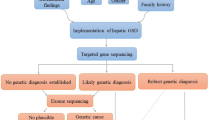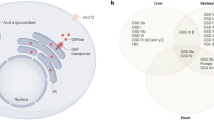Abstract
Background
Glycogen storage disease type V (GSDV) is an autosomal recessive metabolic condition caused by pathogenic PYGM variants. This is an underdiagnosed condition as it presents with exercise intolerance in children. We reviewed the GSDV cases of a tertiary hospital center to assess diagnostic timing/accuracy, as well as potential clinical/analytical predictors of such factors.
Methods
We retrospectively reviewed all GSDV cases with follow-up in both Pediatric and Adult Metabolic Diseases consultations. We included 28 cases and assessed their hospital record for clinical information.
Results
Over 90% of our cases had late diagnoses, with more than 50% being diagnosed in adulthood despite symptom onset in preschool (very late diagnosis). Diagnostic age was lower in patients exhibiting myoglobinuria. Interestingly, patients with a positive family history of GSDV had similar rates of very late diagnoses, likely since the index case was already detected very late in life. Finally, we observe that the R50* variant is associated with increased myoglobinuria and CK elevation, in a dosage-dependent manner.
Conclusion
We concluded that GSDV is severely underdiagnosed, and that some clinical and analytical aspects of the condition can be more indicative of this diagnosis. Furthermore, we propose for the first time a genotype–phenotype correlation in GSDV.
Impact
-
GSDV is a pediatric-onset metabolic disorder that is mostly diagnosed late in the adult age and commonly misdiagnosed.
-
We observed the first genotype–phenotype correlation in GSDV, regarding the common R50* variant.
-
Awareness of GSDV for pediatricians and the overall medical community is vital.
This is a preview of subscription content, access via your institution
Access options
Subscribe to this journal
Receive 14 print issues and online access
$259.00 per year
only $18.50 per issue
Buy this article
- Purchase on Springer Link
- Instant access to full article PDF
Prices may be subject to local taxes which are calculated during checkout



Similar content being viewed by others
Data availability
All data regarding this work are present in the manuscript and its online materials.
References
Martín, M.A., Lucia, A., Arenas, J. & Andreu, A.L. Glycogen storage disease type V. In (eds Adam. M.P., et al.) GeneReviews® [Internet]: University of Washington (Seattle (WA), 1993).
Vieitez, I. et al. Molecular and clinical study of McArdle’s disease in a cohort of 123 European patients. Identification of 20 novel mutations. Neuromuscul. Disord. 21, 817–823 (2011).
Lucia, A. et al. Genotypic and phenotypic features of McArdle disease: insights from the Spanish national registry. J. Neurol. Neurosurg. Psychiatry 83, 322–328 (2012).
Lucia, A., Martinuzzi, A., Nogales-Gadea, G., Quinlivan, R. & Reason, S. Clinical practice guidelines for glycogen storage disease V & VII (McArdle disease and Tarui disease) from an international study group. Neuromuscul. Disord. 31, 1296–1310 (2021).
Milstein, J. M., Herron, T. M. & Haas, J. E. Fatal infantile muscle phosphorylase deficiency. J. Child Neurol. 4, 186–188 (1989).
Bartram, C., Edwards, R. H., Clague, J. & Beynon, R. J. McArdle’s disease: a nonsense mutation in exon 1 of the muscle glycogen phosphorylase gene explains some but not all cases. Hum. Mol. Genet 2, 1291–1293 (1993).
Nogales-Gadea, G. et al. Exercise and preexercise nutrition as treatment for McArdle disease. Med. Sci. Sports Exerc. 48, 673–679 (2016).
Bollig, G. Sports and McArdle disease (glycogen storage disease type V): danger or therapy? [Internet]. In (eds Khan, J. & Hsieh, P.-S.) Ch 10 (Rijeka, IntechOpen). https://doi.org/10.5772/intechopen.89204 (2019).
Bollig, G. McArdle’s disease (glycogen storage disease type V) and anesthesia—a case report and review of the literature. Paediatr. Anaesth. 23, 817–823 (2013).
Vladutiu, G. D. Genetic predisposition to statin myopathy. Curr. Opin. Rheumatol. 20, 648–655 (2008).
Martín, M. A. et al. Molecular heterogeneity of myophosphorylase deficiency (McArdle’s disease): a genotype-phenotype correlation study. Ann. Neurol. 50, 574–581 (2001).
Martinuzzi, A. et al. Phenotype modulators in myophosphorylase deficiency. Ann. Neurol. 53, 497–502 (2003).
Bruno, C. et al. McArdle disease: the mutation spectrum of PYGM in a large Italian cohort. Hum. Mutat. 27, 718 (2006).
Quinlivan, R. et al. McArdle disease: a clinical review. J. Neurol. Neurosurg. Psychiatry 81, 1182–1188 (2010).
Santalla, A. et al. Genotypic and phenotypic features of all Spanish patients with McArdle disease: a 2016 update. BMC Genomics 18, 819 (2017).
Nogales-Gadea, G. et al. Next-generation sequencing to estimate the prevalence of a great unknown: McArdle disease. Genet Med. 17, 679–680 (2015).
Scalco, R. S. et al. Misdiagnosis is an important factor for diagnostic delay in McArdle disease. Neuromuscul. Disord. 27, 852–855 (2017).
Maté-Munoz, J. L. et al. Favorable responses to acute and chronic exercise in McArdle patients. Clin. J. Sport Med. 17, 297–303 (2007).
Rommel, O. et al. Muscle pain in myophosphorylase deficiency (McArdle’s disease): the role of gender, genotype, and pain-related coping. Pain 124, 295–304 (2006).
Gariani, K., Nascimento, M., Superti-Furga, A. & Tran, C. Clouds over IMD? Perspectives for inherited metabolic diseases in adults from a retrospective cohort study in two Swiss adult metabolic clinics. Orphanet J. Rare Dis. 15, 210 (2020).
Duno, M., Quinlivan, R., Vissing, J. & Schwartz, M. High‐resolution melting facilitates mutation screening of PYGM in patients with McArdle disease. Ann. Hum. Genet 73, 292–297 (2009).
Nogales-Gadea, G. et al. Knock-in mice for the R50X mutation in the PYGM gene present with McArdle disease. Brain 135, 2048–2057 (2012).
Funding
Funding was provided by UMIB—Unidade Multidisciplinar de Investigação Biomédica, ICBAS—Instituto de Ciências Biomédicas Abel Salazar, Universidade do Porto, Porto, Portugal, and by ITR—Laboratory for Integrative and Translational Research in Population Health, Porto, Portugal, both supported by FCT—Fundação para a Ciência e a Tecnologia in the frameworks of UIDP/00215/2020; LA/P/0064/2020.
Author information
Authors and Affiliations
Contributions
All authors met the Pediatric Research authorship requirements. J.D.D.S., A.P. and N.T. conceived and designed the study. J.D.D.S., A.P., A.R.S., A.G., S.R., M.C., C.G., C.A.S., I.S.N., A.M.F., D.Q., S. F., R.R., M.S. and E.M. acquired data. J.D.D.S. and A.P. analyzed and interpreted the data. J.D.D.S. and A.P. drafted the article. All authors revised the manuscript and provided final approval for publication.
Corresponding author
Ethics declarations
Competing interests
The authors declare no competing interests.
Consent for publication
Patient consent was not required and waived by the host institution as all data were obtained by a retrospective analysis of non-identifiable clinical data from the hospital’s electronic records.
Additional information
Publisher’s note Springer Nature remains neutral with regard to jurisdictional claims in published maps and institutional affiliations.
Supplementary information
Rights and permissions
Springer Nature or its licensor (e.g. a society or other partner) holds exclusive rights to this article under a publishing agreement with the author(s) or other rightsholder(s); author self-archiving of the accepted manuscript version of this article is solely governed by the terms of such publishing agreement and applicable law.
About this article
Cite this article
Da Silva, J.D., Pereira, Â., Soares, A.R. et al. Diagnostic accuracy and the first genotype–phenotype correlation in glycogen storage disease type V. Pediatr Res (2023). https://doi.org/10.1038/s41390-023-02943-1
Received:
Revised:
Accepted:
Published:
DOI: https://doi.org/10.1038/s41390-023-02943-1



